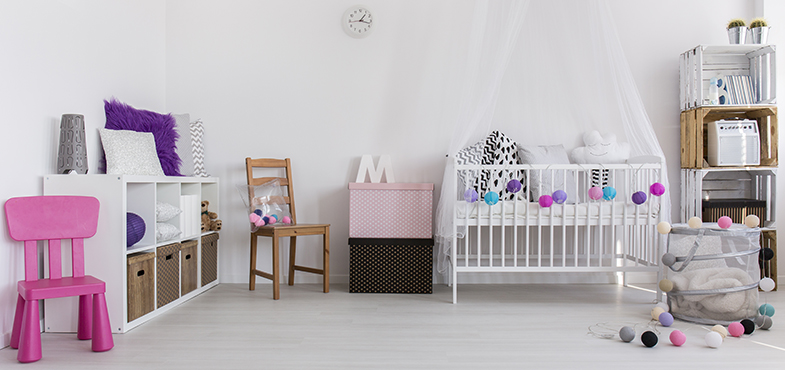Ideas for Preparing a Baby’s Nursery
When your baby arrives, you will be the center of her universe. And that universe will be largely centered around the baby area.
You and your baby are both going to spend a lot of time in the baby area, especially when you first bring your baby home, so it's important to make it a calm, comfortable place for both of you.
The Right Environment
Your baby's nursery — whether it's in your bedroom or in a separate room — should be a quiet area where there is subdued lighting and little traffic. Remember, your baby will spend most of the time here looking up, so make sure there are no bright overhead lights.
The baby area should be a peaceful place, designed for ease of use and comfort for you and for your baby. Arrange the furniture and items in a way you think makes the most sense logically, but realize that you may need to rearrange things a little once you figure out what works best for both of you.
Benefits of a Bassinet
In the first months of infancy, you may prefer a bassinet. These portable baby beds can be carried from room to room so you can keep a close watch on your sleeping baby.
A bassinet is not a necessity. And because most bassinets will not support the weight of an older baby, they're useful only for the first four or five months, which makes them a bit of a luxury item.
Choosing a Crib
Your newborn's needs are simple: a firm, flat mattress and a safe enclosure where she will feel protected and secure.
When choosing a new crib or borrowing an old one, make sure that:
The crib slats are no more than two and three eighths (2 3/8) inches apart to prevent your baby's body from slipping through. Ensure there are no missing or cracked slats
The mattress fits snugly. You should be able to fit no more than two fingers between the mattress and the side of the crib. Remove any plastic coverings. If a sheet is used, make sure it is a tight, fitted sheet.
The top section of the corner post is no higher than 1/16 of an inch, or no shorter than 16 inches if there's a canopy, to avoid snagging your baby's clothes or causing injury
There are no decorative cutouts in the headboard or footboard — they could catch your baby's head or limbs
To prevent entanglement, be sure to remove all mobile or hanging items by the time your baby is 4 months old or begins to pull herself up. And when your baby is less than four months, make sure the mobile is out of reach and securely fastened so it can't fall into the crib
The crib is never near a window with blind, curtain cords or baby monitor cords; babies can strangle themselves on cords. Never place a crib near windows where the window is accessible from the crib
The crib does not have drop sides — these are no longer permitted per the latest safety guidelines and federal regulations
All crib parts are secure using original hardware. Makeshift repairs can be unsafe
Sleep Safety
To reduce the risk of Sudden Infant Death Syndrome (SIDS), your baby should be placed on her back when it's time to sleep. Remember the phrase "Back to Sleep," and be sure that everyone who cares for your child follows this rule, even at naptime
The sleeping surface must be firm and flat
Fluffy pillows, crib bumpers, blankets and toys should never be placed in the crib with a sleeping baby
Do not use sleep-positioning devices. These may look like a good idea, but your baby can become trapped and suffocate
Your baby can be kept warm by using a sleeper, such as a zipper sleeper. Do not use sleepers that can ride up and potentially cover your baby’s face
For more on baby sleep safety, read http://www.smartparenting.com.ph/kids/baby/what-you-need-to-know-about-s....
Changing Table
For changing diapers you can use a changing table specifically designed for that purpose. You can also use a flat, secure surface (like the floor or bed), covered with a changing mat or towel. Whatever you choose, be sure the surface is sturdy.
If you buy a changing table, make sure that:
The changing table is sturdy and stable, with a 2-inch guardrail around all four sides. The top of the changing table should be concave, so that the middle is slightly lower than the sides
You secure the changing table to the wall (to the studs), if possible, to prevent tip-overs. If the table has wheels, be sure they are locked
Have all your supplies ready before you change your baby. Make sure they are within your reach, but out of your baby’s reach. Do not give your baby product containers to hold while you are changing her; give her a toy to hold instead
Never leave your baby alone on a changing table, not even for a minute. ALWAYS keep one hand on your baby when using a changing table, even when you are using the provided safety strap.Ignore the phone during this time — your baby’s safety comes first!
Moms around the world trust JOHNSON’S® to care for their babies
We are committed to working with moms, healthcare experts and scientists to ensure our products continue achieving the highest JOHNSON’S® baby standards.
Learn how we're making JOHNSON’S® products even better for your baby >
Getting Your Baby Ready, Too
Learn how to stimulate baby’s healthy development while in the womb.

Childproofing
Besides the nursery, you’ll want to take steps to make the rest of your home safe for your baby. Visit BabyCenter® to learn what to do both before your baby arrives and as she grows.
